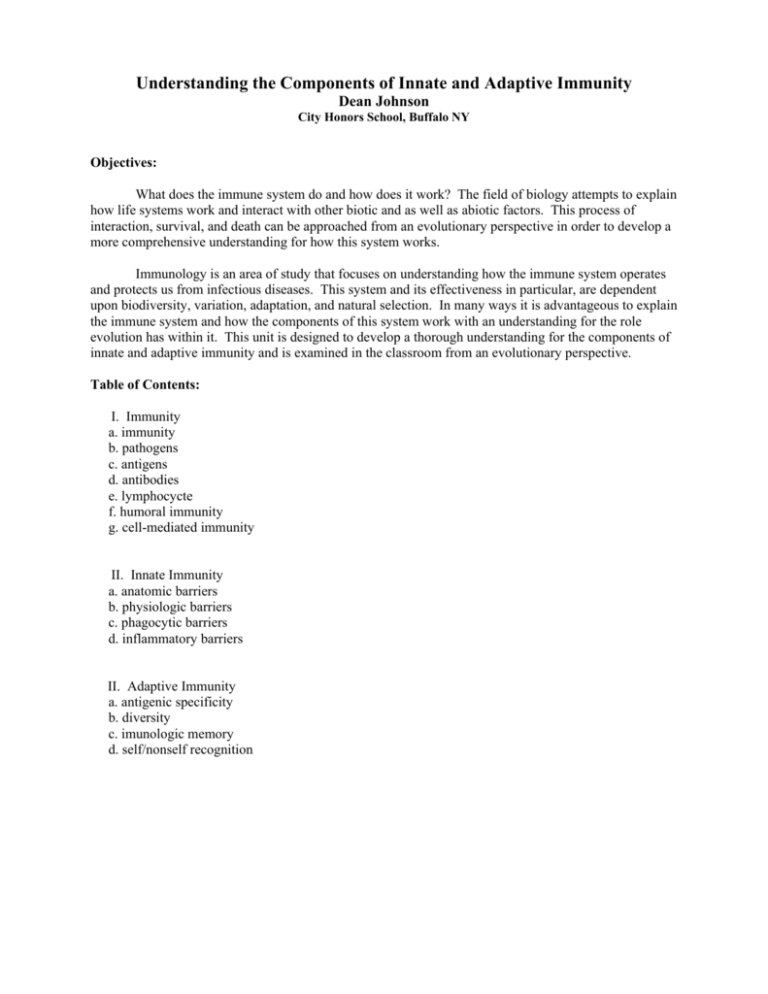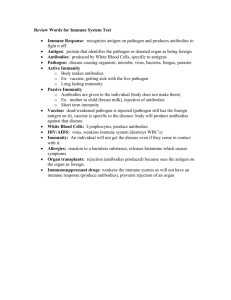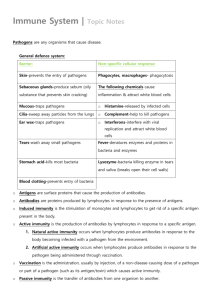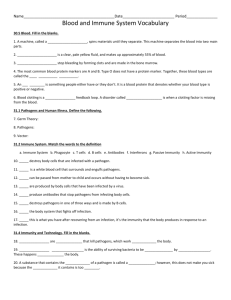Understanding the Components of Innate and Adaptive Immunity
advertisement

Understanding the Components of Innate and Adaptive Immunity Dean Johnson City Honors School, Buffalo NY Objectives: What does the immune system do and how does it work? The field of biology attempts to explain how life systems work and interact with other biotic and as well as abiotic factors. This process of interaction, survival, and death can be approached from an evolutionary perspective in order to develop a more comprehensive understanding for how this system works. Immunology is an area of study that focuses on understanding how the immune system operates and protects us from infectious diseases. This system and its effectiveness in particular, are dependent upon biodiversity, variation, adaptation, and natural selection. In many ways it is advantageous to explain the immune system and how the components of this system work with an understanding for the role evolution has within it. This unit is designed to develop a thorough understanding for the components of innate and adaptive immunity and is examined in the classroom from an evolutionary perspective. Table of Contents: I. Immunity a. immunity b. pathogens c. antigens d. antibodies e. lymphocycte f. humoral immunity g. cell-mediated immunity II. Innate Immunity a. anatomic barriers b. physiologic barriers c. phagocytic barriers d. inflammatory barriers II. Adaptive Immunity a. antigenic specificity b. diversity c. imunologic memory d. self/nonself recognition Stranger in the House -ImmunityDean Johnson Objectives: 1.) The students will learn about the basic components of the immune system and assimilate an understanding for them using a real life scenario with familiar applications. 2.) The class will understand and be able to explain what pathogens, antigens, antibodies, and lymphocyctes are and how they relate to humoral and cell-mediated immunity. Introduction: This lesson is designed to allow students the opportunity to develop an understanding for innate and adaptive immunity by relating its components to a real life scenario. This activity does not require many materials and can be modified according to the needs of the students. The activity portion of this lesson will be used to develop a working definition for immunity, pathogens, antigens, and antibodies. Materials: ♦ 4 groups of students ♦ 4 index cards ♦ 4 transparencies and markers Procedure: 1. The class will be divided up into four groups, with one person being responsible for writing, and one person responsible for speaking. 2. One index card will be distributed to each group that describes the scenario that they are responsible for working on. 3. The job of each group is to place themselves in a particular scenario and determine what course of action they would take. 4. All possible options must be explored and written down, and actions must be justified. After the groups have discussed their scenario and plan, the writer should write down the scenario they were given and describe how they dealt with it. 5. Each of the four index cards will have one scenario. Scenario I: You are home alone and it is 12:30 at night. Your parents are out of town and are not expected back until the following day. You wake up from a deep sleep when you hear a loud noise outside in the street. What are your options and which one would you be most likely to take? The sound is nonspecific, and could generate many different responses. The main point that this should be used to illustrate is that the immune system has primary and secondary defenses as well as specific and nonspecific defenses. This loud noise in the street could be a potential danger (such as somebody who sitting next to you in class who is visibly sick), but, at this point it probably will generate no significant response from the person in the house (your immune system). Scenario II: You are home alone and it is 12:30 at night. Your parents are out of town and are not expected back until the following day. You are awakened from a sound sleep when you hear a loud noise downstairs. What are your options and which one would you be most likely to take? The sound is once again nonspecific, however, it would most likely generate a different response from the one generated from scenario I . The possible responses are many and analogously could be applied to a nonspecific secondary immune response. The potential danger is in the house (body), and the person who was sleeping in the house could respond to this situation in several different ways. The immune system has phagocytes and macrophages, which are leukocytes that can provide nonspecific secondary defense against pathogens. Scenario III: You are home alone and it is 12:30 at night. Your parents are out of town and are not expected back until the following day. You wake up from a sound sleep when you hear a window break downstairs. What are your options and which one would you most likely take? This situation could generate several different responses, and these all should be explored and and developed. This scenario, however, could be used to develop an understanding for an inflammatory response generated from a foreign object penetrating the surface of the skin. The broken window (skin) could cause the person sleeping (histamines) to call the police (phagocytes) who will respond and remove the potential threat (pathogen/bacteria). Scenario IV: You are home alone and it is 12:30 at night. Your parents are out of town and are not expected back until the following day. You wake from a sound sleep when you hear somebody downstairs. What are your options and which one would you take? This situation could also generate several different responses, however, these all can be used to generate an understanding for specific secondary defense mechanisms in the immune system. The role of pathogens, antigens, b lymphocytes, antibodies, t lymphocytes, and helper and suppressor t lymphocytes should be developed and explained. 6. After each group has had approximately 10-15 minutes to work on the activity, each group is asked to explain their scenario and the actions they decided to take as a result. Input: 1. The class will be introduced to the new unit on immunology and asked to share what they know about the immune system with the rest of the class. What does our immune system do? 2. The general ideas will be written down on the chalkboard as a word splash, and these concepts will be related back to the stranger in the house scenario in order to define their functions. 3. What are pathogens and how do they relate to diseases? Discuss Koch’s Postulates, viruses, bacteria, protists, and fungi. How are pathogens transmitted? 4. What are the means of detection that the immune system utilizes and how can these factors be related back to the stranger in the house scenario? How do antigens, antibodies, and B and T lymphocytes relate to this system? Closure: What is the difference between humoral and cell-mediated immunity and how do they conceptually relate to the stranger in the house scenario? Does the Chicken Have Anthrax? -Innate ImmunityDean Johnson Objectives: 1.) The students will be able to explain how each of the components of innate immunity function in the protection of the body. 2.) The student will develop an understanding for how these defenses work by conducting a scientific investigation using common household items. Introduction: Innate immunity is the first line of defense against pathogens and is an evolving system of protection that works in cooperation with adaptive forms of immunity. The purpose of this inquiry based activity, is for the students to develop an understanding for the components of nonspecific immunity by utilizing a scientific approach. This activity addresses three different defenses that are incorporated into innate immunity. The first nonspecific defense that this activity examines is skin. The students can develop an understanding for the role skin has within the body’s immune system with the use of hard boiled eggs or apples and water with food coloring in it. The apple skin and hard eggshell offer protection to the apple and egg that is analogous to that of the skin and our bodies. A second defense offered by innate immunity is a fever. The human body, under normal conditions, maintains an internal temperature of 98.6oF. The body is, however, capable of generating an immune response that intentionally raises the internal temperature that results in a fever. This is one example of an innate immune response that helps the immune system defend the body against pathogens. This activity allows the students to develop a hands on appreciation for this concept utilizing yeast, sugar, and water. Yeast is a unicellular organism that utilizes alcoholic fermentation in order to generate energy. The temperature of the yeast’s environment, however, significantly affects this process. Yeast does not grow at temperatures between 0o – 10o C and dies at temperatures above 50oC. The optimal growth rate for yeast occurs between 30oC – 37oC. Many organisms, such as yeast, also are influenced by the pH of their environment. Yeast grow well in solutions whose pH is neutral or mildly acidic. The third portion of this activity allows the students to observe the effects that vinegar (whose pH is approximately 3.5) has on the growth of yeast. This activity can be used to discuss the roles that sweat and body oils have in the immune system. Materials: 6 groups of students, with each group receiving the following: ♦ 1 apple or hardboiled egg ♦ 1 plastic knife ♦ 1000mL beaker filled with 500mL of water and 10 drops of food coloring(color can vary) ♦ vinegar ♦ lukewarm water ♦ hot water ♦ 3-5 grams of sugar ♦ yeast ♦ zip lock bags Procedure: 1. The anticipatory set for this activity is the question: Are chickens susceptible to anthrax? (The answer is no, because their body temperature is too high (41oC – 45oC) for the anthrax to survive. The body temperature of humans is 37oC) The students will not be given the answer until they complete the activity. 2. The class will be divided up into 6 groups of four and given instructions for how the activity will proceed. 3. Each group will be given an apple and a freshly cut section of an apple. They will also be supplied with a 1000mL beaker filled with 500mL of water and 10 drops of food coloring. 4. The first aspect of this investigation is for the students to place the whole apple and the freshly cut section in the beaker for 10 minutes (while they are waiting they can set up the other experiment involving the yeast). The purpose of this activity is to determine how these two apples will be affected when they are placed in the beaker. 5. The students will be asked to form a hypothesis, write the procedure, record their observations, and develop a conclusion (the students can use a plastic knife in order to cut into the apples and make better observations). 6. The students must record their observations and note whether the whole apple and the cut section experience any color change. 7. The second portion of this activity requires students to determine the effects that temperature and pH have on yeast mortality (the students must first have an understanding for cellular respiration and alcoholic fermentation). 8. Each group will be given 3 zip lock bags with an equal amount of yeast and sugar in them. 9. They will be asked to collect 100mL of boiling water from the hot water bath using a 250mL beaker and with the assistance of the instructor. They will also collect 100mL of lukewarm water from a water bath that is regulated at 800 F and 100mL of vineger. 10. Each of these beakers will be poured carefully into one of each of the zip lock bags, and the bags will be sealed. 11. After 10 minutes have elapsed, the students will make observations on these three bags and the viability of the yeast. 12. After all of their observations and conclusions have been recorded, the groups will share their results as a class. 13. This discussion will be used to develop an understanding for innate immunity and its four component defenses which are: anatomic barriers (skin and mucous), physiologic barriers (temperature, pH, and chemical mediators), phagocytic barriers (specialized cells), and inflammatory barriers (leakage of vascular fluids). Closure: The students will be reminded of the question they were asked at the beginning of the class regarding chickens and their susceptibility to anthrax. Chickens have evolved in such a way that they have innate immune protection against anthrax because their body temperature is too high for anthrax to survive. I Am A Pathogen! Adaptive Immunity Dean Johnson Objectives: 1.) The students will develop an understanding for how antigenic specificity allows the immune system to distinguish subtle differences among antigens. 2.) The class will be able to explain how an immunologic memory can induce a heightened state of immune reactivity. 3.) The students learn about the functional cells of the immune system and understand how these cells distinguish between self and non-self cells. Introduction: This activity allows the students to develop a hands-on appreciation for the components of specific immunity. The students work with the concepts of adaptive immunity by utilizing tangible materials and objects and create analogous associations. Materials: ♦ colored balloons (6 red, 6 yellow, 6 blue, 6 green balloons) ♦ 30 colored toothpicks (5 red, 5 yellow, 5 blue, 5 green toothpicks) ♦ 40 purple, yellow, blue, and green colored square stickers (double sided adhesive) ♦ 6 index cards ♦ 6 large garbage bags Procedure: 1.) One group of eight students will be given a box of 25 different color balloons 5 red balloons z 5 yellow balloons z 5 blue balloons z 5 green balloons z 2.) This group of students will stand in the hall until the activity begins, and will each be given an index card that indicates that they will be acting as pathogens. When they are asked to enter the room, they will pick up a balloon and will be analogous to a pathogen entering the body. The pathogen entering the body indicates that it was able get past the body’s first line of defense. 3.) Each index card will also indicate which color square (antibody) can stick to each color balloon (pathogen). If the sticker (antibody) is specific for the balloon (pathogen), then it sticks to the pathogen and the person who attached the antibody will sit down. If it is not specific for that pathogen, then the person holding the pathogen says: “I am a pathogen”, which will indicate to the antibody that it cannot bind to it. When the antibody does not bind the pathogen, then the toothpick (cytotoxic T) cell can pop (kill) the balloon (pathogen) as long as it is specific for that pathogen (the pathogen will indicate whether it is specific by saying nothing, or is not specific by say: “I am a pathogen”. 4.) Another group of eight students will each be provided with an index card of instructions and a sheet of double sided adhesive square stickers, 5 green, 5 blue, 5 purple, and 5 yellow (antibodies). If an antibody binds a pathogen, then it sticks to it and stays in its’ location. The person holding the balloon sets it down on the floor and this person returns to the hall and continues to bring in pathogens. The person who stuck the antibody to the balloon also returns to their group. Every time an antibody binds, the double-sided adhesive square will stick to the previously bound pathogen. 5.) Another group of two students will each be provided with three large garbage bags, which will represent a phagocyte. As soon as three pathogens have been tagged by an antibody and stuck together, then the phagocyte can place the mass of antibody bound pathogens in the bag and seal it. 6.) The last group of six students will be provide with eight toothpicks, which will simulate the cytotoxic T cells. Each student will receive one red, blue, green, and yellow toothpick. These cells can attempt an attack on any pathogen that is not tagged by an antibody, however, they must wait for the pathogen to say nothing, then they can attack and pop (kill) the balloon, or say: “I am a pathogen”, which means that this cytotoxic cell is not specific to this pathogen and return to their seat. 7.) Each student in a group will be given an index card specific to their identity. Pathogen Index Card: You are a Pathogen! You are a disease- causing agent, such as a bacteria, virus, or fungi that is about to attack a human body (classroom). You are susceptible to antibodies and cytotoxic T cells. There are, however, only certain ones that can harm you! The following antibodies (squares) can bind (stick) to you and killer T cells(toothpicks) can kill (pop) you. Balloon color Square color Toothpick color Pathogen z redz yellowz yellowz bluez bluez greenz greenz red Antibody Antibody Index Card: green binds blue no binding Killer T Cell green toothpick attacks green toothpick attacks purple binding red toothpick attacks yellow no binding red toothpick attacks green binding blue no binding purple binding yellow no binding yellow toothpick attacks yellow toothpick attacks blue toothpick attacks blue toothpick attacks You are an Antibody! You are a protein that helps the body destroy pathogens (foreign invaders). You are involved in a type of immunity called humoral immunity. The body in this activity is the classroom and your job is to defend it to the best of your ability. Each member of the group was given a sheet of double sided adhesive square stickers: 5 green, 5 blue, 5 purple, and 5 yellow (antibodies). The challenge for your group is to try to determine which color antibody binds to each of the different colored balloons (pathogens). Initially this will be trial and error, however, as the activity proceeds, you should be able to determine which antibodies can bind to each color balloon. The activity will proceed in a specific order, meaning that the antibody in this group with the number 1 in the lower right hand corner will go first. As each pathogen enters the room , one person from the group will act as an antibody and attempt to bind to the pathogen the colored square they believe will be most effective. If the pathogen says nothing after confronting it within ten seconds, then place the adhesive square you selected on the balloon. If the pathogen says: “I am a pathogen”, this indicates that this antibody you selected cannot bind to this particular pathogen. After you have place the sticker on the balloon or have been informed that you are not specific for that pathogen, please return to your seat. However, it your sticker does bind and there is a balloon(s) on the floor that also has an antibody bound, then stick the two balloons together and then sit down (leave the balloons on the floor). Good Luck! #1 Macrophage Index Card: You are a Macrophage! You are a white blood cell that engulfs or digests pathogens (foreign invaders) in the body. You are involved in a type of immunity called humoral immunity. The body in this activity is the classroom and your job is to defend it to the best of your ability. Each group member was given 3 large garbage bags (macrophages). You are responsible for engulfing masses of pathogens (balloons) that have antibodies (square, colored stickers) bound to them. When there is a mass of three antibody-bound pathogens, you can take one of the bags and place the mass inside of it and return to your group with this bag. Good Luck! #1 Cytotoxic T Cell Index Card: You are a Cytotoxic T Cell! You are a type of white blood cell that attacks pathogens (foreign invaders) directly by transferring proteins into the cell membrane of the pathogen and causing fluid from inside the cell to leak out of the membrane. You are involved in a type of immunity called cell-mediated immunity. The body in this activity is the classroom and your job is to defend it to the best of your ability. You have the ability to attack the pathogen directly and in this activity you will try to attack any pathogens that make it past the humoral response (antibodies) by confronting the pathogen. When you confront the pathogen you have a choice of using a red, blue, yellow, or green toothpick. The pathogen will say: “My antigens are what ever color the balloon is”, which will indicate that you may attack the pathogen by popping (killing) the balloon (pathogen) with the toothpick; or they may respond by saying: “I am a pathogen”, which means that particular colored toothpick (Cytotoxic T cell) cannot kill this pathogen). Group members must confront the pathogens individually and once per round, meaning that if one group member attacked the pathogen and could not kill it, then that pathogen survived the round. Students must also proceed in the correct order, by referring to the number on your index card in the lower right-hand corner. Good Luck! #1 Input: The focus of the discussion should center around developing an understanding for adaptive immunity and recognizing how antigenic specificity, diversity, imunologic memory, and self/nonself recognition relate to this type of response. The discussion should also develop some of the components that were left out of this activity that are critical to cell-mediated immunity. Helper T cells identify antigens present on pathogens and turn on or initiate the release of cytotoxic T cells that are specific to this type of antigen. Suppressor T cells suppress the release of cytotoxic T cells once the pathogen has been destroyed. It is also important for the students to understand that phagocytes are capable of engulfing pathogens before they have infected a cell, however, once this infection has occurred, the system can utilize antibodies, cytotoxic T cells, or macrophages. Antibodies are capable of binding to pathogens and forming large masses of antibody bound pathogens that can be engulfed later by macrophages. Cytotoxic T cells can kill pathogens directly, however, they must be specific to that particular pathogen and it’s antigens. This, aforementioned, is regulated by helper and suppresser T cells. Closure: Review and explore the interconnections between pathogens, antigens, antibodies, lymphocytes, humoral immunity, and cell-mediated immunity.









